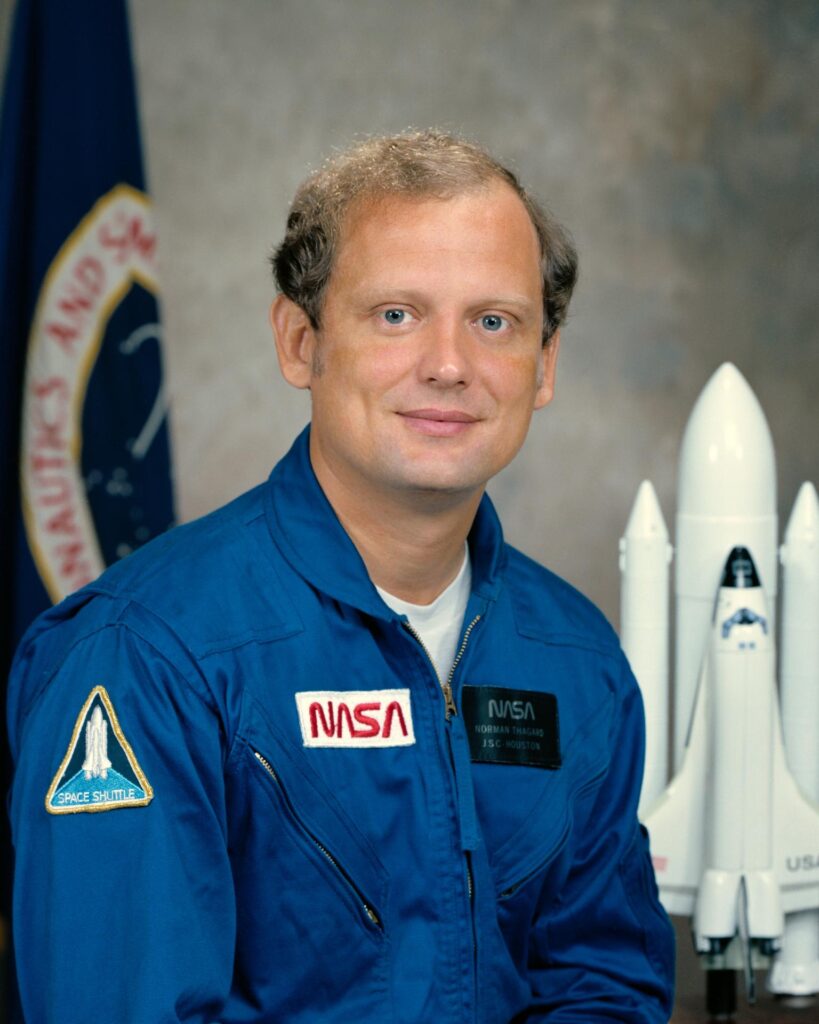Norman Thagard was born on July 3, 1943, in Marianna, Florida, but considers Jacksonville, Florida his hometown. Thagard told his high school classmates that he wanted to be a medical doctor, a fighter pilot, an engineer, and an astronaut. He became all four. He graduated from Paxon Senior High School in Jacksonville in 1961. Thagard attended Florida State University (FSU) and received Bachelor and Master of Science degrees in Engineering Science from FSU in 1965 and 1966, respectively. In 1977 he earned a Doctor of Medicine degree from the University of Texas Southwestern Medical School.
In September 1966, Thagard entered active duty with the United States Marine Corps Reserve. He achieved the rank of captain in 1967 and was designated a naval aviator in 1968, assigned to fly F-4s with VMFA-333 at the Marine Corps Air Station in Beaufort, South Carolina. He flew 163 combat missions in Vietnam while assigned to VMFA-115 from January 1969 to 1970. He then returned to the United States to be an aviation weapons division officer with VMFA-251 at Beaufort. He has logged over 2,200 hours flying time, the majority in jet aircraft.
Thagard resumed his academic studies in 1971, and after earning his doctorate in 1977, interned in the Department of Internal Medicine at the Medical University of South Carolina. Dr. Thagard was selected to be an astronaut candidate by NASA in January 1978 and became eligible for future space shuttle missions in August 1979. He was a mission specialist on STS-7 in 1983, STS 51-B in 1985, and STS-30 in 1989. He was payload commander on STS-42 in 1992 and served as a cosmonaut-researcher on the Russian Mir-18 mission in 1995.
Dr. Thagard’s first entered space aboard STS-7 on June 8, 1983. Like all shuttle flights, it launched from Kennedy Space Center (KSC), Florida. This was the second flight for the Orbiter Challenger and the first mission with a crew of five. The crew deployed satellites for Canada and Indonesia and operated the Canadian-built Remote Manipulator System (RMS) to perform the first deployment and retrieval exercise with the Shuttle Pallet Satellite (Dr. Thagard retrieved the rotating satellite with the RMS). The mission included the first formation flying of the Orbiter with a free-flying satellite and carried the first U.S./German cooperative materials science payload. During the flight, Dr. Thagard also conducted various medical tests and collected data on physiological changes associated with astronaut adaptation to space. After 147 hours, the Challenger landed at Edwards Air Force Base (AFB), California, on June 24, 1983.
Norman Thagard next entered space on STS 51-B Challenger, the Spacelab-3 science mission, which launched on April 29, 1985. He assisted the commander and pilot on ascent and entry. Thagard’s duties on orbit included satellite deployment operation with the NUSAT satellite as well as caring for the 24 rats and two squirrel monkeys contained in the Research Animal Holding Facility. After 110 orbits of the Earth, in 168 hours Challenger landed at Edwards AFB on May 6, 1985.
Thagard was aboard STS-30 Atlantis, which launched on May 4, 1989. During this mission, crew members deployed the Magellan Venus-exploration spacecraft (the first U.S. planetary science mission in nine years), which was also the first planetary probe to be deployed from the Shuttle. In addition, the crew worked on secondary payloads involving fluid research in chemistry and electrical storm studies. Following 64 orbits in 97 hours Atlantis landed at Edwards AFB on May 8, 1989.
Dr. Thagard next served as payload commander on STS-42 Discovery, which lifted off on January 22, 1992. Fifty-five major experiments conducted in the International Microgravity Laboratory-1 module were provided by investigators from eleven countries and represented a broad spectrum of scientific disciplines. During 128 orbits of the Earth, the STS-42 crew investigated the effects of microgravity on materials processing and life sciences. Experiments included investigating microgravity’s effects on the growth of protein and semiconductor crystals. Biological experiments included the effects of zero gravity on living tissues, bacteria, insects, and human vestibular responses were also conducted. After eight days in orbit, STS-42 landed at Edwards AFB on January 30, 1992.
Dr. Thagard’s fifth space flight was as a cosmonaut-researcher on the Russian Mir EO-18 crew on the space station Mir, along with cosmonauts Vladimir Nikolayevich Dezhurov and Gennadi Mikhailovich Strekalov. Liftoff was from the Baikanor Cosmodrome in Kazakhstan on March 14, 1995. Thagard became the first American to train on Russian soil, the first to enter space aboard a non-American craft, and the first American occupant of the Mir. He helped conduct 28 experiments in the course of the 115-day flight. Thagard, Dezhurov, and Strekalov landed at KSC aboard STS-71 Atlantis on July 7, 1995.
With the completion of his fifth mission, Dr. Thagard logged over 140.56 days in space.
Norman Thagard is currently a tenured professor of electrical engineering and dean of public relations at the FSU/FAMU College of Engineering. He also serves as the director of the Challenger Learning Center in Tallahassee, Florida, and is on the boards of various private corporations.
Captain Thagard has earned eleven Air Medals, the Navy Commendation Medal with Combat “V” and the Marine Corps “E” Award, the Vietnam Service Medal, and the Vietnamese Cross of Gallantry with Palm.

